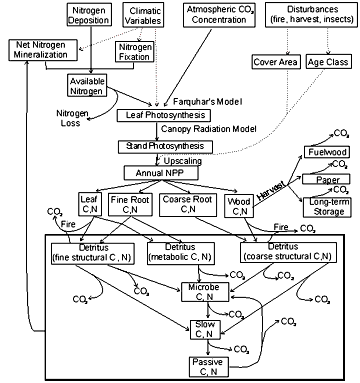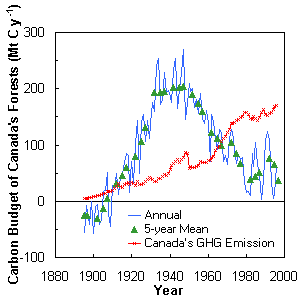|
InTEC, an Integrated Terrestrial Ecosystem C-budget
model, was developed to estimate the carbon budget of Canada's
forests by a government-industry scientific team from CCRS
and Intermap Technologies Ltd. (Chen et al., 1998a). The InTEC
model estimates the carbon budgets of forests from atmospheric,
climatic and biotic changes since the pre-industrial period
(Figure 1). The atmospheric changes include the increases
in carbon dioxide concentration and nitrogen deposition. The
climatic changes include inter-annual variations in temperature
and precipitation. The biotic changes include forest area
and age structural changes due to disturbances caused by forest
fires, insects and timber harvest. Based on these changes,
the effects of various biological and physical processes on
the carbon budget of forest ecosystems are modeled. Processes
considered in the model include nitrogen deposition, fixation
and deposition, carbon release due to disturbances, forest
regrowth, change in the length of the growing season, CO2
fertilization, soil respiration, and changes in carbon/nitrogen
ratios of different components in biomass and soil carbon
pools.

Figure 1 Structure of the
Integrated Terrestrial Ecosystem C-budget model (InTEC) which
synthesizes the interactive effects of disturbances, nitrogen
deposition, climate change, and CO2 fertilization on the carbon
budget of boreal forests. Dashed arrows indicate influences,
and solid arrows show C-N flows.
The main characteristic of the model is the mechanistic integration
of two widely used models: the Century model for carbon and
nitrogen cycles in soils, and Farquhar's biochemical model
of leaf photosynthesis. The integration is implemented through
new spatial and temporal scaling algorithms developed in this
study. The spatial scaling from leaf to canopy is done with
a canopy radiation model with sunlit/shaded leaf separation.
The temporal scaling from minutes to a year is conducted using
statistics of variance and covariance of various meteorological
and biological factors involved in photosynthesis. The statistics
are obtained from the measurements of two boreal species from
1994-1996 (Chen et al., 1998b; Goulden, et al., 1998). This
temporal scheme allows the estimation of annual total photosynthesis
using annual mean meteorological measurements such as temperature
and precipitation and yet is able to take into account the
effects of diurnal and seasonal variability of the photosynthetic
processes on the integrated carbon budget. A similar temporal
scaling method was used for inter-annual variations in NPP
and in other factors such as nitrogen deposition, climate,
CO2 and disturbance rates. Disturbances are considered explicitly
in this model as processes that directly release carbon and
nitrogen into the atmosphere, and modify the total NPP by
changing forest area and age class. The carbon cycle in forest
products is also included as a process which stores a fraction
of harvested wood in products that slowly oxidize. Sub-models
of respiration and canopy photosynthesis are verified and
parameterized using BOREAS data at the Old Black Spruce (1995
and 1996) and Old Aspen (1994 and 1996) sites. In particular,
we determine the time fraction of photosynthesis dominated
by the electron transport control or Rubisco activities after
separating a canopy into sunlit and shaded leaf groups, thus
avoiding a large uncertainty in using Farquhar's model to
determine canopy photosynthesis and inter annual variation
in NPP. Remote sensing derived data of leaf area and NPP,
network measurements of N deposition, and historical data
of climate and disturbance rates are used in the InTEC model.
InTEC results indicate that in the past 100 years, Canada's
forests as a whole were a small carbon source of about 30
Mt C y-1 in the period 1895-1905 due to large disturbances
near the end of the 19th century; a large carbon sink of about
170 Mt C y-1 (1930-1970) due to forest regrowth in previously
burnt areas; and moderate carbon sinks of about 50 Mt C y-1(1980-1996)
(Figure 2). The 1980-1996 sink is a net balance between the
negative effects of increased disturbances and the positive
effects of other non-disturbance factors. In order of importance,
the non-disturbance factors, were found to be
- atmospheric nitrogen deposition measured by a national
monitoring network,
- net nitrogen mineralization and fixation estimated from
temperature and precipitation records,
- CO2 fertilization estimated from CO2 records using a leaf
level photosynthesis model,
- growing season length increase estimated from spring air
temperature records.

Figure 2 Carbon budget of
Canada's forests from 1895 to 1996. Five-year means are plotted,
the last point being only the average from 1995 to 1996. Also
included is the record of Canada's green-house gas carbon
emission rate
The positive effect of these non-disturbance factors is experimentally
supported by the recent BOREAS measurements. Increased disturbances
(mostly fire and insects) in recent decades caused a loss
of about 60 Mt C y-1 from the forests in 1980-1996. If disturbance
rates had remained unchanged, Canada's forests in 1980-1996
would have been a sink of about 150 Mt C y-1 in size. The
large amount of carbon accumulated during 1930-1970 with low
disturbance rates caused an additional loss of about 40 Mt
C y-1 through decomposition in 1980-1996. From the modeling
perspective, it is evident that:
- attention must be given to nutrient cycles as they are
particularly closely coupled with carbon cycle in the boreal
environment,
- estimating the carbon budget from historical changes in
nitrogen and carbon cycle components is the preferred approach
since the outcome is not sensitive to inaccuracies in estimates
of soil respiration andNPP
- the absolute magnitude of current sinks per unit area
is small (about 0.35 t C/ha or 13% of current NPP) and exceedingly
difficult to measure directly.
To reduce the uncertainties in our estimates, improvements are therefore needed in the comprehensive modeling of all processes involved in the terrestrial nutrient and carbon cycles using biological and physical principles which can be experimentally verified.
|